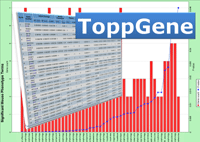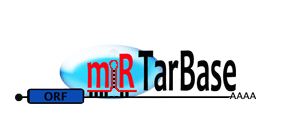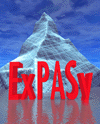
ToppGene Suite
A one-stop portal for gene list enrichment analysis and
candidate gene prioritization
based on functional
annotations and protein interactions network
Entrez Gene

A database for gene annotations
WebsiteEuropean Molecular Biology Laboratory

EMBL is at the forefront of innovation in life sciences research, technology development and transfer, and provides outstanding training and services to the scientific community in its member states. This publicly-funded non-profit institute is housed at five sites in Europe whose expertise covers the whole spectrum of molecular biology.
WebsiteGene Ontology

The Gene Ontology project provides a controlled vocabulary to describe gene and gene product attributes in any organism.
WebsiteHuman Phenotype Ontology
Human Phenotype Ontology is a controlled vocabulary of terms - an ontology - for 8,000 abnormalities commonly associated with human monogenic diseases, and manually annotated entries in the Online Mendelian Inheritance in Man database with these terms, providing a community resource for cross-disease phenotypic comparisons.
WebsiteMammalian Phenotype

MGI-Mouse Genome Informatics. Mouse Informatics from Jackson Laboratories.
WebsiteGeneSigDB
GeneSigDB is a searchable database of fully traceable, standardized, annotated gene signatures which have been manually curated from publications that are indexed in PubMed.
WebsitemiRTarBase

miRTarBase has accumulated more than three thousand miRNA-target interactions (MTIs), which are collected by manually surveying pertinent literature after data mining of the text systematically to filter research articles related to functional studies of miRNAs. Generally, the collected MTIs are validated experimentally by reporter assay, western blot, or microarray experiments with overexpression or knockdown of miRNAs. miRTarBase currently curates 4,270 experimentally verified MTIs between 669 miRNAs and 2,533 target genes among 14 species. While containing the largest amount of validated MTIs, the miRTarBase provides the most updated collection by comparing with other similar, previously developed databases.
WebsitePITA
A PITA site denotes a single microRNA binding site prediction on a given UTR (and has a ΔΔG value). There can be (and in many cases are) many sites for the same microRNA along a given UTR. The target score represents the overall effect of all those sites combined together on the given UTR. If a microRNA has a single site on the UTR then the target score is equal to that site's ΔΔG. However, if more than one site exists for a given microRNA on a given UTR then the target score appropriately sums up the ΔΔG energies of all those sites.
WebsitemicroRNA.org - Targets and Expression
The microRNA.org website is a comprehensive resource of microRNA target predictions and expression profiles. Target predictions are based on a development of the miRanda algorithm which incorporates current biological knowledge on target rules and on the use of an up-to-date compendium of mammalian microRNAs. The target sites predicted by miRanda are scored for likelihood of mRNA downregulation using mirSVR, a regression model that is trained on sequence and contextual features of the predicted miRNA::mRNA duplex. Expression profiles are derived from a comprehensive sequencing project of a large set of mammalian tissues and cell lines of normal and disease origin.
WebsiteGWAS Central
GWAS Central (previously the Human Genome Variation database of Genotype-to-Phenotype information) is a database of summary level findings from genetic association studies, both large and small. We actively gather datasets from public domain projects, and encourage direct data submission from the community.
WebsiteBiomolecular Interaction Network Database

BIND is a database designed to store full descriptions of interactions, molecular complexes and pathways. This database is also used for obtaining protein-protein interactions.
WebsiteThe Human Protein Reference Database

HPRD is an expert curated database containing interaction networks, disease associations, and post-translation modifications for each protein in the human proteome. This database is also used for obtaining protein-protein interactions.
WebsiteGeneral Repository for Interaction Datasets

BioGRID is a freely accessible database of protein and genetic interactions.
WebsiteComparative Toxicogenomics Database

Comparative Toxicogenomics Database (CTD) is a community-supported public resource. It is being developed at the Mount Desert Island Biological Laboratory (MDIBL), a Marine and Freshwater Biomedical Science (MFBS) Center of the National Institutes of Environmental Health Sciences (NIEHS).
WebsiteSTITCH

STITCH is a resource to explore known and predicted interactions of chemicals and proteins. Chemicals are linked to other chemicals and proteins by evidence derived from experiments, databases and the literature.
WebsiteKyoto Encyclopedia of Genes and Genomes - KEGG

KEGG PATHWAY is a collection of manually drawn pathway maps representing our knowledge on the molecular interaction and reaction networks.
WebsiteBioCyc

BioCyc is a collection of Pathway/Genome Databases describing the genome and the metabolic pathways. ToppGene Suite uses the HumanCyc database which is a collection of human metabolic pathways and the genes associated with each one of them.
WebsiteBioCarta Pathways

BioCarta pathways is a database of pathways and the corresponding genes associated with each one of them.
WebsiteSmall Molecule Pathway Database
SMPDB (The Small Molecule Pathway Database) is an interactive, visual database containing more than 350 small molecule pathways found in humans. More than 2/3 of these pathways (>280) are not found in any other pathway database.
WebsitePanther Pathways

The PANTHER (Protein ANalysis THrough Evolutionary Relationships) Classification System is a unique resource that classifies genes by their functions, using published scientific experimental evidence and evolutionary relationships to predict function even in the absence of direct experimental evidence. Proteins are classified by expert biologists into families and subfamilies of shared function, which are then categorized by molecular function and biological process ontology terms.
WebsiteReactome

Reactome is a curated resource of core pathways and reactions in human biology. The information in this database is cross-referenced with PubMed, GO, and the sequence databases at NCBI, Ensembl and UniProt.
WebsiteUniprot - Expasy

An EBI database of proteins cross-referenced to multiple databases such as family and domain databases.
WebsitePubmed

PubMed is a service of the U.S. National Library of Medicine that includes over 16 million citations from MEDLINE and other life science journals for biomedical articles back to the 1950s.
WebsiteTargetScan

TargetScan database stores predicted regulatory targets of mammalian microRNAs. Targets are predicted using TargetScanS algorithm by searching for the presence of conserved 8mer and 7mer sites that match the seed region of each miRNA.
WebsitePicTar
PicTar is an algorithm and database for predicted miRNA targets.
WebsiteMSigDB

The Molecular Signatures Database (MSigDB) is a collection of gene sets for use with GSEA software. MSigDB data are used in several ToppGene Suite features.
WebsiteDrug Bank
The DrugBank database is a unique bioinformatics and cheminformatics resource that combines detailed drug (i.e. chemical, pharmacological and pharmaceutical) data with comprehensive drug target (i.e. sequence, structure, and pathway) information.
WebsiteOther Useful Links
|
The Genome Browser provides a wealth of
genomic information presented in the form of graphical images and
links to external internet sites.
|
||





